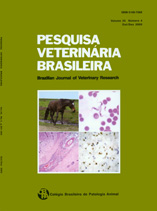 |
|
|
|
Year 2005 - Volume 25, Number 4
|

|
Intoxicação por Baccharidastrum triplinervium (Asteraceae) em bovinos, p.235-238
|
Langohr I.M., Gava A. & Barros C.S.L. 2005. [Poisoning in cattle by Baccharidastrum triplinervium (Asteraceae).] Intoxicação por Baccharidastrum triplinervium (Asteraceae) em bovinos. Pesquisa Veterinária Brasileira 25(4):235-238. Animal Disease Diagnostic Laboratory, Purdue University, 406 South University, West Lafayette, IN 47907, Estados Unidos. E-mail: ilangohr@purdue.edu
An outbreak of poisoning by Baccharidastrum triplinervium in cattle from Paraná, Brazil, is described. The disease occurred during a severe drought in early summer. The onset of clinical signs was two days after 50 cows and 8 heifers had been introduced into a pasture with high density of B. triplinervium that showed signs of having been consumed by the animals. Fifteen animals (9 cows and 6 heifers) got sick. Of these 15, two cows and four heifers died after a clinical course of 12-60 hours. Clinical signs included depression, ruminal atony, moderate bloat, marked dehydration, mild diarrhea and anorexia. The animals were restless, laying down and getting up constantly, remaining progressively longer periods in sternal recumbency. Once in that position, the animals had an extended head or the head turned to one of the sides of the body, and were groaning. Additionally, the cows had an abrupt fall in milk yield. The remaining affected cattle presented milder clinical signs and were partially back to their feed on the day following the onset of the clinical signs. The milk production was back to normal values within one week. The main gross lesions observed in two necropsied cows were in the forestomachs and abomasum, consisting of edema of the ruminal wall, as well as of diffuse reddening of the mucosae of the rumen, reticulum, abomasum and of some of the omasal folds. The main histological lesions included multifocal ballooning degeneration and necrosis of the lining epithelium of the rumen, associated with neutrophilic infiltrate. The diagnosis was based on the epidemiological data and on the experimental reproduction of the disease by force-feeding 3 bovine with the aeral fresh parts (20 and 30g/kg) of B. triplinervium. Chemical analysis of dried material from B. triplinervium harvested at the site of the outbreak was negative for macrocyclic trichothecenes. |
| |
|
|
| |
|
 |